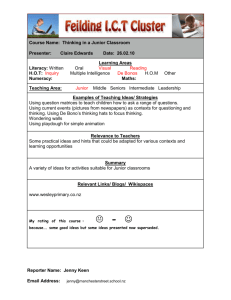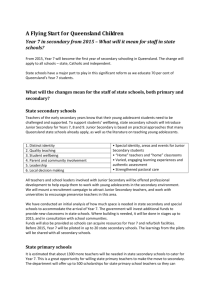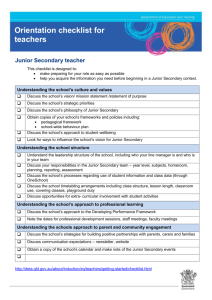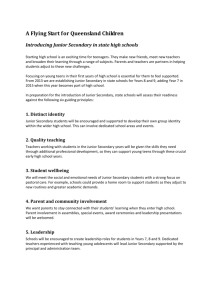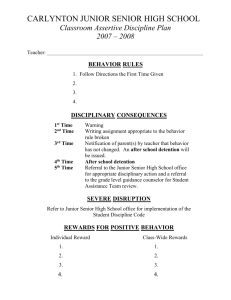DOC 18KB - Flying Start
advertisement
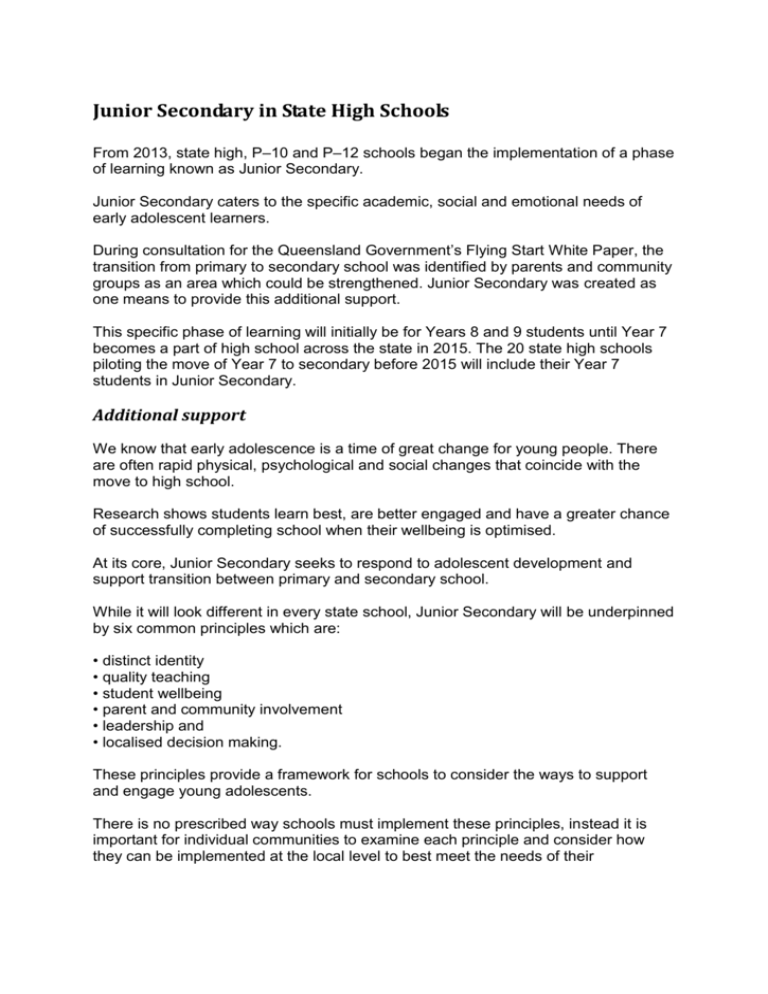
Junior Secondary in State High Schools From 2013, state high, P–10 and P–12 schools began the implementation of a phase of learning known as Junior Secondary. Junior Secondary caters to the specific academic, social and emotional needs of early adolescent learners. During consultation for the Queensland Government’s Flying Start White Paper, the transition from primary to secondary school was identified by parents and community groups as an area which could be strengthened. Junior Secondary was created as one means to provide this additional support. This specific phase of learning will initially be for Years 8 and 9 students until Year 7 becomes a part of high school across the state in 2015. The 20 state high schools piloting the move of Year 7 to secondary before 2015 will include their Year 7 students in Junior Secondary. Additional support We know that early adolescence is a time of great change for young people. There are often rapid physical, psychological and social changes that coincide with the move to high school. Research shows students learn best, are better engaged and have a greater chance of successfully completing school when their wellbeing is optimised. At its core, Junior Secondary seeks to respond to adolescent development and support transition between primary and secondary school. While it will look different in every state school, Junior Secondary will be underpinned by six common principles which are: • distinct identity • quality teaching • student wellbeing • parent and community involvement • leadership and • localised decision making. These principles provide a framework for schools to consider the ways to support and engage young adolescents. There is no prescribed way schools must implement these principles, instead it is important for individual communities to examine each principle and consider how they can be implemented at the local level to best meet the needs of their Junior Secondary students. Junior Secondary Teachers An important consideration with the implementation of Junior Secondary has been to ensure we have Junior Secondary teachers with the right skills, capabilities and attributes that will enable them to effectively manage the distinct learning needs of young adolescents. As such, a suite of initiatives, including scholarships and professional development opportunities, is being developed by the department to support current state school teachers who wish to work with students in the Junior Secondary years. Junior Secondary teachers will help to play a key role in ensuring the bridge between primary and secondary school is safe, strong and consistent for all students. Supporting the transition to Junior Secondary Starting high school is a really exciting time, and the implementation of Junior Secondary aims to ensure that the transition from primary school to high school is seamless. Outside of the classroom, there are some simple steps parents and carers can take to help your child get ready for high school. Tomorrow’s Queensland: strong, The year before high school Attend a parent information session prior to enrolling your child to ensure you are comfortable with the academic program offered by your chosen high school. Speak to your chosen school about any allergies, medical conditions or special needs your child may have. The school may have specific programs available to support your child. Encourage your child to participate in any orientation and transition programs offered by either their primary school, or their new high school. It will help smooth the way. Be enthusiastic about the move to high school and begin to talk positively to your child about the transition. Listen to any concerns or worries and reinforce the things your child is excited about. High school will have a wealth of new experiences for them to enjoy. Check out our starting high school videos and other useful resources about the transition to high school at www.flyingstart.qld.gov.au. Encourage your child to use a diary to plan events and activities. Support your child to be more independent and responsible by doing jobs at home and preparing themselves for the school day. Visit the high school’s website. You and your child can find out lots more about the school’s curriculum and activities. Starting high school Buy school uniforms, school bag, school shoes, school books and required stationery with your child, if possible. If your child will be taking public transport to school, do a test run of the journey to and from school, so they’ll feel comfortable come day one. If your child is meeting you after school, ensure they know where to meet you. Make any arrangements for before or after school care and ensure your child has a range of emergency contact details and a key for home should any plans fall through. Ensure your child has a private and quiet space and the necessary equipment to successfully study out of school hours. Help them to develop a study plan around their other commitments and activities. Have regular conversations with your child about being safe. Discuss what they should do if they experience any inappropriate interactions. Talk about the school routine and timetables and familiarise your child with the map of the school. Make sure your child knows where to go on the first day i.e. where to meet the teachers. This information is generally included in information sessions and discussed in orientation and transition programs that you and your child will have participated in, in the year before. Talk positively to your child about the change. Be realistic with them about the time it will take to settle into new routines. Identify things to look forward to e.g. making new friends, experiencing new subjects. Identify some goals. Set your child up with an older student buddy from the school. This student may be able to share information about the school routines and procedures that will help your child to feel more comfortable. Arrange for your child to arrive at school on day one and meet a friend at a predetermined time and location. Your child will then be more comfortable. In the first term of high school Practice good organisational skills. For the first few weeks check with your child which subjects they have each day, what books they need and whether they’ve completed required homework. Ensure your school has all of your relevant contact information and be sure to check the different ways the school will communicate with parents. Remind your child to mark all important dates in their school diary – this could be things like assignments or school events. Consider ways that you might be able to stay involved with your child’s learning in high school – it may be by volunteering for the P&C, or committing to attend parent information nights or school events. Attend welcome events and parent information opportunities offered by the school. Find out who is best to contact at the school to assist and support you and your child e.g. year coordinator, Head of Special Education Services, or the Year Level Deputy Principal. Contact your child’s teachers and discuss with them how you can work together to support your child. Regular email contact is often an efficient way to keep in touch. Make sure you read the school’s newsletter. Many schools now have online newsletters that you can receive by email. Make sure you have registered to receive these. Get into the habit of checking your child’s diary regularly. Help your child to plan for completing homework and assessment tasks on time. Encourage your child to bring lunch from home at least for the first few days. This means one less thing for your child to have to think about when they are getting used to the new routines. Help your child to get into the habit of being on time to school each day. Ensure the school is always notified if your child is late or absent. Encourage your child to join in an extra-curricular activity or school event e.g. club, team, study group. This is a great way to meet new friends and explore all aspects of school life. A good working relationship with your school is essential. Clear and open communication will help your school meet the needs of your child.

